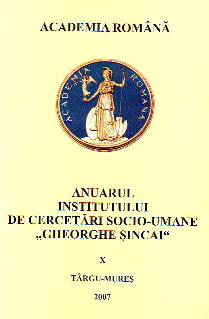Structurile socio-profesionale şi organizatorice ale formaţiunilor politice româneşti din Austro-Ungaria (1867-1918)
The social-political and organizing structures of the Romanian political formations in the Austrian-Hungarian Empire
Author(s): Ioan ChioreanSubject(s): History
Published by: Institutul de Cercetări Socio-Umane Gheorghe Şincai al Academiei Române
Keywords: Austro-Hungary; 19th century; political organization; the Romanian National Party from Banat and Hungary; Transylvania; Bukovina
Summary/Abstract: The debates in the Parliament of Hungary in the period 1865-1868 brought about some changes in the future thinking and activity of the majority of Romanian politicians, in what the necessity of the foundation of political organizations was concerned. Consequently, the foundation conference of the Romanian National Party from Banat and Hungary took place on 7 February 1869, in Timişoara. Alexandru Mocioni was elected president of the party, and, according to the adopted program, he established activism as a political platform. In a similar conference, at Miercurea, which took place between 7-8 March 1869, the Romanian Transylvanian leaders decided at their turn to found a separate national party, with a program almost identical with the one during the 1848 Revolution. The tactics of abstaining from the electoral activity was adopted on this occasion. It was equivalent to the non-recognition of dualism and of the annexation of Transylvania to Hungary. In the following period, a series of troubles in the frame of the Romanian national movement took place and led to the enforcement of the passivist trend and, finally, to the unification of the two parties in 1881 and the adoption of a program structured in 9 points. Now, that the Romanian bourgeoisie succeeded in taking over the entire leadership of the national movement in Transylvania, the adoption of the passivist tactics by the entire party was imposed as an objective necessity. In conformity with the decision adopted at the conference on the fusion of the two Romanian political parties, Bariţiu drafted a memorial in 1882, a reference document of the Romanian national movement, announcing, a decade before, the great memorandum movement in 1892. In Bukovina, the beginnings of the Romanians’ political organization were more modest, but, after 1900, the parties and their ideological orientations diversified. Mention must be made in this sense of Romanian national party from Bukovina, the National popular party, the Romanian conservative party (“pactist”), the Democrat peasant party, the Party of defense, the Social Christian party. We have to point out that Romanian political social-democrat organizations were founded both in Transylvania and Bukovina, which were going to collaborate with the national parties in these provinces in the fall of 1918, preparing together the Great Union from 1918.
Journal: Anuarul Institutului de Cercetări Socio-Umane »Gheorghe Şincai« al Academiei Române
- Issue Year: 2007
- Issue No: 10
- Page Range: 186-221
- Page Count: 36
- Language: Romanian

